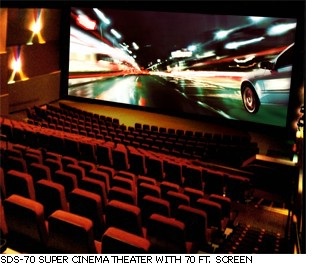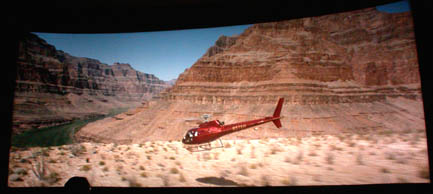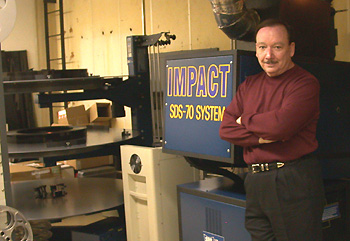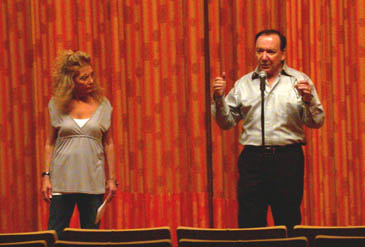Super Dimensional Xperience |
Read more
at in70mm.com The 70mm Newsletter |
| Written by: Rick Mitchell, Film Editor/Film Historian/Film Director © 2007, Universe rights reserved. | Date: 10.11.2007 |
 We boomer movie fans have long lamented the decline in the quality of
the theatrical moviegoing experience over the last forty years. Of
course the production-distribution end of the industry no longer really
cares about exhibition, viewing it as a high priced publicity venue for
the ultimate home video release. But exhibition doesn't really seem to
care about providing older potential moviegoers especially with a
desirable alternative to the home video setups owned by those who can
afford them. While they finally seem to have gotten out of the shoebox
theater mindset, their current goal seems to be making the theater
experience more like the home situation rather than something special
and unique; the question of why people other than hype influenced
trendoids would be willing to go out and pay $10-20 for an experience
they can have at home for free doesn't seem to have occurred to them. We boomer movie fans have long lamented the decline in the quality of
the theatrical moviegoing experience over the last forty years. Of
course the production-distribution end of the industry no longer really
cares about exhibition, viewing it as a high priced publicity venue for
the ultimate home video release. But exhibition doesn't really seem to
care about providing older potential moviegoers especially with a
desirable alternative to the home video setups owned by those who can
afford them. While they finally seem to have gotten out of the shoebox
theater mindset, their current goal seems to be making the theater
experience more like the home situation rather than something special
and unique; the question of why people other than hype influenced
trendoids would be willing to go out and pay $10-20 for an experience
they can have at home for free doesn't seem to have occurred to them.
Actually, all the technological advances that have enhanced the moviegoing experience and have been embraced by audiences: sound, color, wide screen, stereophonic sound, and to a so far limited degree, 3-D, have initially come from outside both the production/distribution and exhibition sides of the industry and only been adopted after their commercial viability had been proven by independent efforts. Unfortunately, given the attitude over the last decade that theatrical exhibition was on life support, with Digital Cinema expected to provide only temporary relief, there seems to be very little serious R&D going on with regard to improving the contemporary moviegoing experience. One person who has been trying is Robert Weisgerber. Nine years ago he began promoting Super Dimension 70, a process using 65mm negative shot and projected at 48 fps., but unlike Imax, designed for narrative feature production and presentation by the roadshow standards of the Sixties. The results are spectacular, easily blowing away Digital Cinema in terms of both sharpness and contrast, on very large screens. And, using digital technology, Weisberger has not only done successful downconversions to 24 fps 35mm anamorphic, but equally spectacular upconversions to 70mm 48 fps from 35mm 1.85 and HD material. |
More
in 70mm reading: Super Dimension 70 Reformatting films in SDS-70´s "DMX" Process Go see this!! Who's Rick Mitchell? Internet link: Super Dimension 70 Super Vista Corporation 245 East 93rd Street, Suite 32 A New York NY 10128 USA +1 212 369 5035 +1 212 348 4136 (fax) Los Angeles +1 818 789 1065 |
 Shot
off the screen from the 70mm print of the demo reel which gives some
idea of the sharpness and clarity of the process. Image by Rich Greenhalgh Shot
off the screen from the 70mm print of the demo reel which gives some
idea of the sharpness and clarity of the process. Image by Rich GreenhalghWeisgerber has an extensive practical background in both production and exhibition and knew that the success of this format would be based on its easy adaptability to existing equipment and production and exhibition situations. Standard Panavision and Arriflex 65 cameras are used in photography as is existing technology in modifying projectors and platters for that end of the process, with DTS' special venue technology for the sound system, all designed for easy installation and removal from standard large auditorium booths. (See attached photo.) Unfortunately, although the process has gotten an enthusiastic reaction from those who have seen it, including members of the American Society of Cinematographers, Weisgerber has been unable to get production or exhibition executive decision makers to view it. With Digital Cinema an inevitability, Weisgerber saw the potential of using 48 fps technology to bring images of 70mm comparable quality to those venues. Working with Digital Jungle in Hollywood, a proprietary DI process was developed not only for 48 frame 2K digital projection, but also for 35mm 48 fps production using essentially the old 2 perf Techniscope format for photography to allow for the standard 1000' loads, but resulting in medium shots and closeups of comparable quality to 65mm, in which ideally the wide shots would be made, in the digital cinema version, and ideally in a 35mm anamorphic filmout as well. (Though film tests apparently haven't been done yet, having seen John Kirk's spectacular photochemical restoration of the Techniscope shot "The Good, the Bad and the Ugly" using the state-of-the-art Super 35 technology of a decade ago, the results of a 24 fps from 48 fps 35mm version should look very good whether done photochemically or digitally, but I know I'll get arguments from both the grain and pixel sides on that.) |
|
 Weisberger
with the Super Dimension 70 projection setup: projector, platter, sound
rack (photographed at the Harmony Gold Theater in Hollywood). Image by Rich Greenhalgh Weisberger
with the Super Dimension 70 projection setup: projector, platter, sound
rack (photographed at the Harmony Gold Theater in Hollywood). Image by Rich GreenhalghOn October 25 and 27, the first public demonstrations of this new process, called Dimensional Movie Xperience, was held at the National Theater in Los Angeles' Westwood district, one of the last old fashioned movie palaces built in the city and now threatened with destruction. The program started with a new print of the Super Dimension 70 presentation film to establish a standard for the program. This was followed by a 35mm anamorphic presentation of the same film, then the DMX conversion from an 8K scan of a 65mm IP (all of Weisgerber's scans are done at 6 to 8K) by 2K digital projection. Allowing for the fact that the digital image was brighter than the film image, often a problem in such presentations, the results appeared to be quite favorable. This was followed by 2K presentations of the "Techniscope" tests. These looked as good as the conversion from 65mm/48 fps. The clincher was a test of scenes from "The Searchers", an interior scene followed by some of the spectacular wide shots made in Monument Valley. The jawdropper was the post-screening revelation that these were taken from the commercial DVD! (A caveat here: the only digital presentations I've seen are presentations of "The Searchers" at the Academy's Dunn Theater and "The Hight and the Mighty" at their Goldwyn, and SMPTE presentations at the Dunn, USC's Norris, the Digital Cinema lab formerly at the Hollywood Pacific Theater, and one of the theaters in the Arclight complex, all theoretically the best state-of-the-art of the time presentations; the DMX 2k presentation looked better than any of these to my photochemically oriented eyes.) This does not mean that Weisgerber has given up on Super Dimension 70. It is his hope that producers shooting wide shots in the process and seeing the high quality of the image in film dailies as well as the downconversion, will decide to shoot the entire film in 65mm. (Theoretically 65mm at 24 fps. or 4 perf 35mm anamorphic at 48 fps can also be used for this purpose, and there¹s the probability that some producer will decide to do everything at 2 perf. 48 fps, but the results will still be better than Super 35.) |
|
 Robert
Weisberger and partner Barrie O'Brien introducing the demonstration at
the National. Image by Rich Greenhalgh Robert
Weisberger and partner Barrie O'Brien introducing the demonstration at
the National. Image by Rich GreenhalghSince the DMX presentation reportedly requires only a simple software installation on existing 2K projectors, this widens the range of opportunities for presenting the 35mm and digital aspects of the demonstration, making it accessible to potential financing sources outside of Los Angeles, and especially in Europe or Asia, where prospects for embracing Super Dimension 70 are more likely than in the United States. And in that regard, though presented at 1.85:1, "The Searchers" clips demonstrate the impact that both these processes can have on dramatic films properly shot to exploit them. And while a great story is a necessity for selling the process, it would be a mistake to follow the attempt to revive 70mm in the Nineties with sober, overly serious period spectacles like "Far and Away" and especially "Hamlet", whose production was clearly inspired by Robert A. Harris and James C. Katz successful restoration of "Lawrence of Arabia", generally considered the ultimate example of the Fifties-Sixties roadshow presentation. However, this type of film is associated in the minds of average contemporary moviegoers with Merchant-Ivory arthouse films and tv's "Masterpiece Theater" As much as critics and cultural snobs abhor it, selling these processes will depend on more "cinematic" material, though it doesn't have to be as intellectually vacuous as "Pirates of the Caribbean: Ad Nauseum". But this introduces another major dilemma: few of today's video addled directors know how to stage and shoot for presentation on the B-I-G W-I-D-E S-C-R-E-E-N. One of those BOURNE things in this process would result in the rest of the day being spent cleaning and disinfecting the theater. Conversations I've had with Weisgerber reveal that he is aware of these problems, too, and hopes to control them as much as possible to get both formats launched. The reported success of Imax versions of dramatic films suggests audiences will still fall for the kind of height that made Cinerama and 3-D temporary successes in the Fifties, and even confused audiences about 70mm in the Eighties by selling it for sound rather than superior image. That both Super Dimension 70 and Dimensional Movie Xperience will deliver on any promised hype is obvious from this demonstration, especially with the right subjects. (Ironically those Imax conversions are presented at shorter aspect ratios ranging from 1.85:1 to 2.40:1, rather than the full height of Imax, which would reveal how impractical Imax is for telling a dramatic story, something for which Super Dimension 70 was designed.) Because the fate of the National Theater is up in the air, future Los Angeles demonstrations are uncertain at the moment, but they are planned and I will pass on announcements as I am informed of them. To those who haven't taken the opportunity to see this, it¹s well worth doing so. |
|
|
Go: back
- top -
back issues
- news index Updated 28-07-24 |
|
